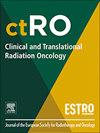Urethra-sparing prostate cancer radiotherapy: Current practices and future insights from an international survey
IF 2.7
3区 医学
Q3 ONCOLOGY
引用次数: 0
Abstract
Purpose
In prostate cancer patients, high radiation doses to the urethra have been associated with an increased risk of severe genitourinary toxicity following dose-escalated radiotherapy. Urethra-sparing techniques have emerged as a promising approach to reduce urinary toxicity. This international survey aims to evaluate current global practices in urethra-sparing and explore future directions for the implementation of this technique in external beam radiotherapy (EBRT) for prostate cancer.
Methods and materials
In April 2024, a survey consisting of 20 questions was distributed to 26 international radiation oncology experts in prostate cancer EBRT, with 23 experts participating. The survey focused on clinical scenarios which might take benefit from urethra-sparing, the definition of the urethra and urinary organs-at-risk, and urethral dose constraints.
Results
Magnetic resonance imaging with T2-weighted sequences is the preferred method for urethra contouring (83 % consensus). Based on the experts opinion, urethra-sparing should be considered for prostate cancer EBRT, regardless of pelvic irradiation, except in cases where the tumor is located within 2 mm of the urethra and/or transitional zone, or in T4 disease. Most experts would not apply specific dose constraints to the urethra for either conventional or moderate hypofractionation regimens. When delivering stereotactic body radiotherapy (SBRT), urethra-sparing with dose hotspot limitation (urethra steering) is recommended by 70 % of the experts, in particular when combined with focal boosting (91 %). Urethra dose-reduction is also the favored approach for salvage prostate reirradiation with SBRT (70 % agreement). Large variations exists regarding urethral dose constraints.
Conclusions
Urethra-sparing is a promising technique for the mitigation of urinary toxicity in prostate cancer patients undergoing EBRT, particularly recommended for ultra-hypofractionation and reirradiation with SBRT. The lack of consensus on specific urethral dose constraints and optimal sparing techniques underscores the need for further research to standardize practices in this field.
保尿道前列腺癌放疗:目前的做法和未来的见解从一项国际调查。
目的:在前列腺癌患者中,高剂量的尿道辐射与剂量递增放疗后严重泌尿生殖系统毒性的风险增加有关。尿道保留技术已成为减少尿毒性的一种有前途的方法。这项国际调查旨在评估目前尿道保留的全球实践,并探讨该技术在前列腺癌外束放疗(EBRT)中实施的未来方向。方法与材料:于2024年4月,对26名国际前列腺癌EBRT放射肿瘤学专家进行问卷调查,问卷共20题,23名专家参与。调查的重点是可能受益于尿道保留的临床情况,尿道和泌尿器官的危险定义,以及尿道剂量限制。结果:t2加权序列磁共振成像是尿道轮廓的首选方法(83%的共识)。根据专家意见,前列腺癌EBRT应考虑保留尿道,无论盆腔是否照射,除非肿瘤位于尿道和/或过渡区2mm以内,或T4疾病。大多数专家不会对常规或中等低分割治疗方案的尿道施加特定的剂量限制。在进行立体定向全身放疗(SBRT)时,70%的专家建议保留尿道并限制剂量热点(尿道转向),特别是与局灶增强(91%)联合使用时。尿道减剂量也是SBRT补救性前列腺再照射的首选方法(70%同意)。尿道剂量限制存在很大差异。结论:对于接受EBRT的前列腺癌患者,保留尿道是一种很有前景的减轻泌尿毒性的技术,特别推荐用于SBRT的超低分割和再照射。由于缺乏对特定尿道剂量限制和最佳保留技术的共识,因此需要进一步研究以规范该领域的实践。
本文章由计算机程序翻译,如有差异,请以英文原文为准。
求助全文
约1分钟内获得全文
求助全文
来源期刊

Clinical and Translational Radiation Oncology
Medicine-Radiology, Nuclear Medicine and Imaging
CiteScore
5.30
自引率
3.20%
发文量
114
审稿时长
40 days
 求助内容:
求助内容: 应助结果提醒方式:
应助结果提醒方式:


